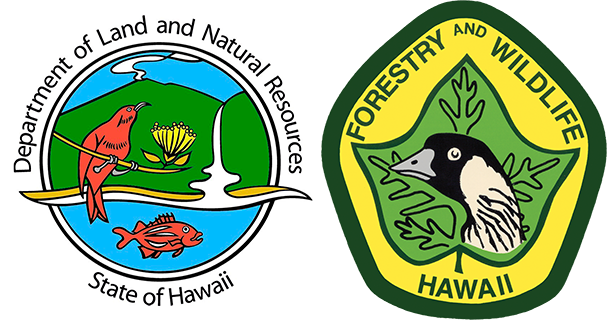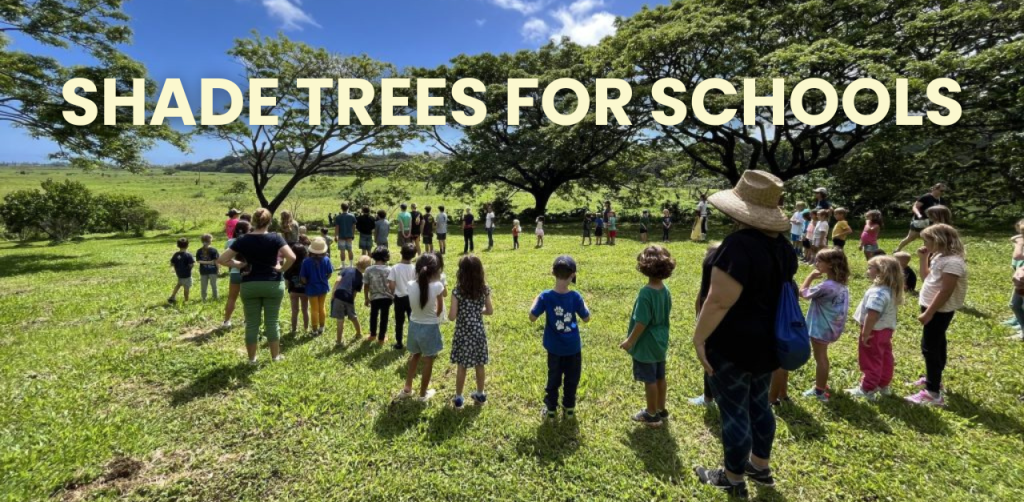Shade Trees for Schools
The Shade Trees for Schools program provides technical assistance to schools, aiding them in selecting the “right tree for the right place”- ensuring trees are planted with long-term health in mind. We provide educational resources to connect public school campus communities across the state to trees already living on their campus, as well as future trees they may add to their campus ʻohana.
If you are interested in learning about trees or planting more on your campus, contact our Campus Forester, Malia Staab, to set up a school visit.
Our Why
Campus trees offer opportunities for students to connect with local ecology, food systems, culture, and art. Mature trees provide shade for rest and play, and provide a cleaner, calmer campus for students. Studies have shown that simply viewing trees and having basic access to green spaces outside the classroom can improve educational outcomes by reducing stress and improving students’ focus and attention spans.
Unfortunately, the vast majority of Hawaiʻi’s schools and surrounding neighborhoods have less than 30% tree canopy cover, which is the minimum amount for spaces to reap these benefits (Konijnendijk, 2022). Planting trees on school campuses can combat this absence, and is necessary for community and personal health.
Benefits of Trees on School Campuses
Campus trees provide students and staff with a number of benefits, including:
-
- Shade and cooling the urban heat island effect; reducing heat stress and cooling costs
- Mature trees remove carbon dioxide and pollutants from the air and reduce noise pollution
- Protect our watersheds by mitigating stormwater runoff and erosion
- Trees on campus help reduce mental and physical stress, encourage students to spend more time outdoors and have been linked with improved academic performance (Dongying & Sullivan 2016, Kuo et al, 2018; Kuo et al, 2021).
- Create community and educational opportunity by connecting us to culture, food, and art
- Read more about the value of trees on our Kaulunani webpage
Urban trees face threats from confined spaces, air and water pollution, soil compaction, urban heat, introduced pests, and poor management such as excessive pruning. Before planting on your campus, make a long-term tree health and care plan to help combat these obstacles.
Where to Start
From knowing what trees work for your campus to long-term care and maintenance, greening your campus can be an overwhelming process. That’s why we are here to help! Here are some first steps to get started.
Plan: Designing and building a plan for tree planting and care is an important step in achieving and maintaining the goals you have for your campus. Here are some things to consider fleshing out:
- Vision: What is your vision and goals for your campus? Consider cultural and educational goals, spatial and resource limitations, and infrastructure. Are you planting trees for shade, lei, food, or classroom connection etc.?
- Select the “right tree for the right place”: When looking for the right tree, consider environmental requirements (soil, sun, water) and how your tree will grow over time (size, shape, productivity of foliage or fruit). When considering the planting location, think about infrastructure limitations both below and above ground (proximity to buildings, sidewalks, powerlines, rooftop PV, underground electrical and water lines). Be sure to compare proposed planting locations with campus utility plans.
- Stewardship: Who will be involved in upkeep and care? What does long-term stewardship look like on your campus?
- Remember that many trees will outlive the student and teacher tenure on campus. How supportive are your facilities team and administration of a long term tree care commitment?
- How can students and teachers be involved in planting events and tree care? What will your district/curriculum allow? (mālama class periods, grade workdays, etc.)
- How can you involve the community in campus tree care? (i.e. community workdays, ʻohana days, etc.)
Permissions: Have a conversation with your administration and facilities team about your planting vision, location, desired tree species, and stewardship plan. For DOE campuses, all proposed planting should be approved in advance by DOE Office of Facilities and Operations (OFO) authorized personnel; site modifications may not be made without prior approval.
Planting: Have a planting event! Planting trees is an opportunity to engage students, facilities, teachers and administrators to foster a relationship between your community and campus tree(s).
- Having signage with tree information can be a way to have continued education after the planting event.
- Plan for the long term care of your tree, consider irrigation and tree protection needs as well as regular upkeep such as weeding and pruning.
- To set your tree up for success, plant in line with the rainy season (Nov-Feb) and avoid new plantings leading up to summertime.
Pilina: How can you continue to build relationship between trees and your campus culture?
- Have regular tree education or care events – celebrate Arbor day every November, create classroom curriculum around campus trees such as lei making or leaf rubbing activities.
- How can you connect campus trees to larger community forestry activities – volunteering with restoration partners, visiting parks or arboretums etc.
- How can you use campus trees as classroom tools – an outdoor learning space, a connection to history, art, culture etc.
Already Celebrating Trees? Become a Tree Campus!
Arbor Day Foundation’s Tree Campus K-12 program inspires the next generation of tree stewards through experiences that bring the benefits of trees to life both inside and outside the classroom.
The program fosters positive connections between youth and the trees in their community and cultivates within its participants a lifelong respect for trees on a global scale.
Want your campus to become a Tree Campus? See which Hawaiʻi schools are current Tree Campuses here, and watch this webinar to learn more about the application process.
Resources and Curriculum
Tree Selection
|
Tree Planting and Care
|
|
Interested in planting fruit trees on campus? Please note that all proposed plantings of agricultural trees on DOE campuses must have prior approval by DOE OFO. All agricultural trees will remain school responsibility to maintain, including but not limited to sanitation, pruning, pest control, and removal if the tree(s) decline or are no longer wanted.
Interested in planting native species on campus?
|
| Classroom Curriculum
Connect students to trees using some of this local and national curriculum:
|
We appreciate everything our teachers do – check out some of these additional resources for more classroom inspiration
|
Contact Us
Malia Staab, Campus Forester, email
Funding for this project provided by the USDA Forest Service, Urban and Community Forestry Program. Kaulunani is an equal opportunity provider.







